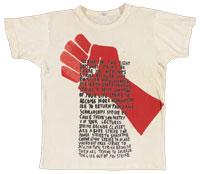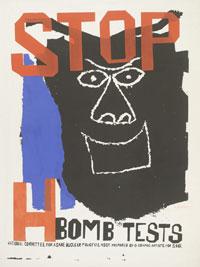Dissent, an exhibit showcasing fine art prints that espouse resistance to oppressive structures, opened at Harvard University’s Fogg Art Museum this week. The collection includes books, postcards, posters, magazines, T-shirts, and playing cards. The prints demonstrate that the need for political dissent has been around for a long time. Pieces range from the seventieth to the twenty-first century.
Because prints can be produced quickly and in large amounts, they’ve long been valued by propagandists and revolutionaries for reaching a wide audience. The powerful messages are extremely effective at immediate engagement; one of the most eye-catching prints in Dissent depicts a student at Ohio State University killed by a national guardsman while protesting the Vietnam War, by Richard Hamilton. Hamilton’s print is a photographic image that still resonates after almost fifty years. The print demonstrates successfully the government’s savage misunderstanding of those times.
Dissent also contains works from famous artists including Andy Warhol and Pablo Picasso. Picasso’s works were the “Dream and Lie of Franco” I and II. These pieces scrutinize the exploits of the infamous Spanish leader in a comic style.
Warhol superimposes Nixon’s head over George McGovern’s in a vote for McGovern poster.
Some of these prints led to social and political change. A 1960s poster massed produced at Harvard and printed in the underground newspaper shows a fist with the word ‘strike’ written on it. Students brandished this poster at demonstrations for increased civil liberties and cultural awareness. The students were successful in their strike. Harvard University made African-American Studies a major concentration.
The most successful prints take something with which everybody is familiar, and add a layer that plays with our common conception of that familiarity. For example, one poster displays the AIDS drug AZT in the form of the logo for Coca-Cola. The AZT piece mocks President Reagan’s Administration for stopping experimental AIDS drugs.
Another piece combines comics and the government in response to 9/11 and shows the leaders of the current Bush Administration bragging about starting a war. Another print that expresses resistance is a poster that shows a silhouette of a hooded Abu Ghraib prisoner above the words ‘Stop BS.’ These weren’t the only Bush bashing pieces. Another is a T-shirt which reads ‘blame Yale.’
The messages on display in Dissent are still relevant. The common theme that unifies these diverse prints is citizens’ duty to resist to the domination of the strong central government. One clever artist parodies several Francisco De Goya pieces to revile the American Religious Right for their supposed hypocrisy. The De Goya works were done in 1799; in one painting he drew demons clipping their toenails to disguise their evils. Chagoya paints the devils as Senator Jesse Helms and Reverend Jerry Falwell and includes the purple Teletubby they accused of being gay. The timeless quality of these prints stems from their historical significance, both the original works and the parody.
Another piece points out the importance of understanding history; it shows an American eagle ripped to shreds above the words, “Don’t look back the past may be gaining on you again.” These images of dissent function as gateways into the past, and this one teaches us not to repeat its mistakes.
Susan Dackerman, a curator at the Fogg, believes that the prints allow for good expression of dissonant opinion. She notes the different ways messages are distributed as she looks over the Fogg’s collection of seventy thousand prints.
Dackerman wants Dissent to further “a public discourse,” and believes “the function of a university art museum is to teach individuals to question received conventional wisdom [through] exhibiting art.” She believes that shows like Dissent are particularly important these days because of the current climate in which expressing opinions that run counter to the “dominant power structure” is labeled unpatriotic. This couldn’t be more opposite from the truth.
DISSENT is being shown through February 25, 2007. The Fogg Museum is open Monday through Saturday from 10AM to 5PM. The Museum is located at 32 Qunicy St, Cambridge, MA 02138. For more information, call 617-495-9400 or visit the the Museum’s Web-site: www.artmuseums.harvard.edu/fogg/






















































